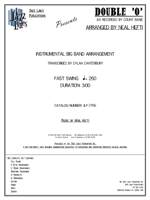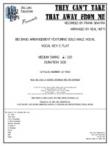DOUBLE 'O'
Recorded by Count Basie
Arranged by Neal Hefti, Transcribed by Dylan Canterbury

Cat #: JLP-7706
$65.00This item usually ships within 1 business day.
Questions?
Please call +1-518-587-1102 or email us.
Edition: Jazz Big Band Arrangement
Description: Swing - Medium Dificult
Publisher: Jazz Lines Publications
Neal Hefti's Double 'O' (AKA Double-O) plays out like a checklist of Count Basie tropes. A simple yet effective melody, crisp ensemble backing figures, and a lengthy tenor saxophone solo all come together to create a highly enjoyable listening and playing experience.
As is the case with so many of the Basie band's charts from the 1950s, the arrangement begins with a piano solo designed to set up the tempo. Eight bars unaccompanied lead into a thrice-repeated "rhythm changes" A section with full rhythm section before the melody enters at measure 18. Saxophones handle the quick-riffing main figure, with a brass fanfare at both the middle and end points of the A section breaking things up. The bridge at measure 26 is rhythmically simple apart from the cascading ensemble trills from measure 30 through 33.
One more A section and a brief cameo trumpet solo break set the stage for a tenor saxophone solo (courtesy of Eddie "Lockjaw" Davis on the original) that largely dominates the rest of the chart. The first chorus of tenor is without backgrounds. The second, beginning at measure 68, has a similar trilled descending line as in the melody during the first and last A sections. The third and final chorus, beginning at measure 100, has a slightly sinister undulating sax line and wah-wah-ing brass during the A sections.
The arrangement comes to a rip-roaring conclusion beginning at measure 124. Some quick, crisp ensemble hits frame a series of tenor and drum breaks. One last trilling descent at measure 132, followed by one more tenor and drum break, set up the shockingly dissonant final ensemble blast to wrap everything up.
This arrangement is for jazz big band. As the original recording only featured three trombones, a fourth trombone part has been created in order to make it playable by a regular section. There are no saxophone doubles.
2 Alto Saxophones
2 Tenor Saxophones
Baritone Saxophone
4 Trumpets
4 Trombones
Guitar
Piano
Bass
Drums
Trombone 1: Bb4










